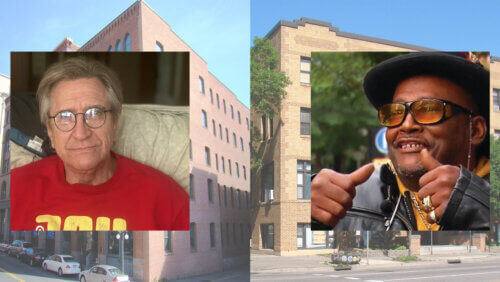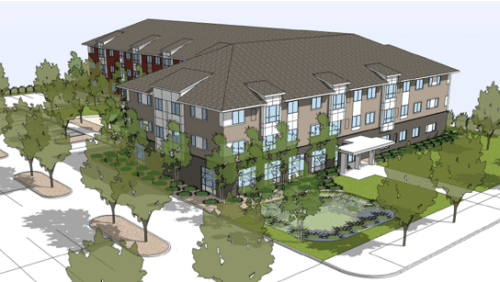Understanding Housing First part 1: Home before anything else
Written by Dylan Novacek, Content Specialist
At Beacon Interfaith Housing Collaborative, we know that the Housing First approach is an important option in the continuum of housing that a community provides. Through developing a deeper understanding of this model, our collaborative will see the role it plays in our work, and why it’s so essential to offer a variety of solutions for home.
Housing First Part 1 – Home Before Anything Else
![]() “Housing First states that housing must be a priority,” shared Danyell Easter, Program Director at Avivo. As the onsite service provider at American House and Kimball Court, Beacon’s two buildings currently in operation under a Housing First model, Danyell and the team work to stabilize residents and provide essential services.
“Housing First states that housing must be a priority,” shared Danyell Easter, Program Director at Avivo. As the onsite service provider at American House and Kimball Court, Beacon’s two buildings currently in operation under a Housing First model, Danyell and the team work to stabilize residents and provide essential services.
“If an individual is stable and secure within their home, then they are more likely to be motivated to work on the other challenges within their life, such as mental and physical health, or addiction,” she continued.
Pictured: Tracey, a resident at Kimball Court
Housing First is a model, first utilized in the 1990s, with a very simple premise: people need the basic foundation of a home without preconditions. Housing First is an intervention for homeless people with severe disabling conditions that combines four elements, as outlined by ‘Homeless Research: A Guide for Economists and Friends’, published in 2019 by the Journal of Housing Economics. These four elements are:
- A program philosophy and practice that values emphasizing consumer choice;
- Community based support services;
- Permanent scatter-site housing;
- Harm reduction to help reduce the risks associated with psychiatric or addiction-related behavior.
The model itself was created in response to a primarily chronically homeless adult population with untreated mental illness and active substance use that were stuck in a cycle of shelter, jail, hospitalization, and living outside. It’s intended to be low barrier in that no income, psychiatric stability, or sobriety is required to be housed.
![]() “This model is based on the idea that housing is a right without any preconditions. It’s essential to individuals who have been oppressed in the housing system,” added John Tribbet, the Service Area Director of Avivo. “It’s an evidence-based practice that works.”
“This model is based on the idea that housing is a right without any preconditions. It’s essential to individuals who have been oppressed in the housing system,” added John Tribbet, the Service Area Director of Avivo. “It’s an evidence-based practice that works.”
“You can’t expect someone to work on things like probation, or finding a job, without having a roof over their head,” Danyell exclaimed. “When we’re talking about Housing First, we’re talking about providing access and opportunities for all people to get housed. At the core of this work, we’re knocking down some of the barriers that are in the way so residents aren’t always in survival mode.”
Pictured: Tony, a resident at American House
As a leading housing developer, it’s important for Beacon to look to our non-profit community and service partners as we develop a greater understanding of what residents need to thrive. In the case of Housing First, Avivo and Beacon look at the realities and challenges this population of homeless individuals who need Housing First face each day.
According to the Minnesota Homeless Mortality Study, the rate of death is three times higher for people who experience homelessness than the general state population. Additionally, the rate of substance related deaths is ten times higher than the general state population.
Housing First combines access to permanent housing with supports, using what is defined as a harm reduction model. The concept of harm reduction is essential to Housing First.
Harm reduction is a set of practical strategies and ideas aimed at reducing the negative consequences associated with drug use, according to the Minnesota Department of Health. Principles of it include an acceptance that drug use is part of our world, acknowledging the harms that come with use, and being non-judgmental to those we aim to help. Additionally, philosophies of harm reduction can apply to other situations such as practicing safe intimacy with a partner, or stabilizing harms around mental health.
“Harm reduction is essentially allowing us to mitigate the harm in people’s lives in a variety of ways as we work towards immediate solutions for those experiencing crisis,” Danyell added.
Housing First, coupled with a harm reduction lens, addresses the inequities created by our current housing systems. As a community of service providers, housing developers, and advocates there is shared growth as we develop ways to positively impact those living with the greatest odds.
At base, the Housing First model closely resembles to that of emergency shelter, with residents finding placement within a single day. There are no program requirements to keep individuals in housing.
“We’re dealing with a highly dysfunctional system that has been in operation for centuries. There is a fundamental need in our society to address poverty and racism,” John asserted. “Housing equals justice. In many ways Housing First gets us closer to that justice.”
We invite you to continue deepening your understanding of Housing First with us. Learn more about how Avivo implements this model at their organization and at some of Beacon’s properties in part two, coming soon.
To learn more about the philosophy of harm reduction, visit harmreduction.org.


